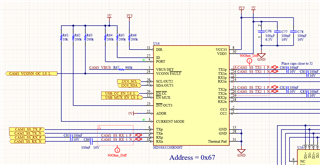Tool/software:
I have some pretty weird behavior going on with this part that I'm trying to get to the bottom of. The device is supposed to be operating in as a DFP. When the device is powered on with a USB cable attached, it is always able to communicate in SS mode regardless of orienation of the cable. However, if the cable is unplugged and plugged back in, it will only operate in SS mode when the cable is in one orientation, but not the other. The same behavior occurs if the device is powered up with no USB cables attached. Tring to get to the bottom of it, I've checked the DIR pin, and it looks like the DIR pin is never being pulled low unless the cable is plugged in at start up and not removed. I also read the Connection Status and Control Register, and saw the following:
Device powered up with cable connected: 0x50 or 0x70 depending on direction
Device powered up with cable attached and then removed: 0x30 in all cases
Device powered up with no cable attached: 0x20
Device powered up with no cable attached and then a cable is attached: 0x20 in all cases
I assume this is an issue with the CC pins, since the CC state is only being set correctly on power on, and not while running, but the CC_EN_L signal is pulled low, as is the MUX_EN_L.
Any ideas?
Thanks,
Matt




